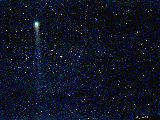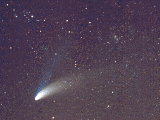Jimr Comet Page


skip to images


Halley [1985-6]
My life was in a bit of tumult during Halley's visit, so other than binocular views from in town I did not see much of it. I was reading astronomy magazines and know in advance that this was not a good orbit to catch it, so I dealt with other matters more pressing than comet-chasing.
Okazaki-Levy-Rudenko [1989]
At this point I had a 10-inch telescope, so fainter comets had become accessible. This was the first of several faint, fuzzy objects with stubby tails. I never saw it reach naked-eye brightness but watched it cruise through Boötes in early autumn.
Levy [1990]
From the Oregon Star Party on Steens Mountain, this comet was easily naked-eye bright with a broad but faint tail. Two nights of briefly clear weather showed it near Aquila in the evening sky. It was the first easy comet since Halley, but Bennett was still the most clearly cometary that I had seen.
Encke [1990]
Honda-Mrkos-Padjuskova [1990]
My first double-comet night came in late summer from the Ochoco Mts. Both were faint, early-morning objects. I believe a third comet was within reach but twilight caught me before I caught it.
Hale-Bopp 1995o1 [1995-6-7]
The first view I had of the future giant was at the Oregon Star Party in August '95, while it still spun through Sagittarius. Just another faint, hazy blob, but this one had a press agent! Again at OSP '96 I caught up with Hale-Bopp as it drifted among summer star-clusters, and wondered if, after Hyakutake, could this comet live up to the hype??
continues below..
Szczepanski 1996b1 [1996]
Another in the group of faint fuzzies, this comet was visible at a Messier Marathon which was full of anticipation of a more prominent comet: Hyakutake was coming! Sadly, clouds in the south kept me from seeing that one for another week.
Hyakutake 1996b2 [1996]
Unbelieveable! This apparition was unparalleled and unforgettable from a dark site, which is where I rushed off to in late March. From southern Portland suburbs I could see about 10 degrees of tail, but the view from Yale Lake stretched from near-vertical to near Spica; I calculated the tail to be nearly 60 degrees long! No longer can I tell people that you can't really watch comets move across the sky; this one drifted among the stars rapidly as it cruised by so near to our planet. I returned the next night despite moon and high clouds, and views were sporadically wonderful again as it neared the Pole Star. The aqua-green color of the comet will not soon be forgotten! Later views in April showed a whitish dust-tail replacing the aqua ion-tail for dominance as the comet neared the Sun. My hastily-constructed photo platform got a hard workout, and rewarded me with several high-quality images.
Kopff [1996]
Another double-comet night, this time at Juniper Sky in central Oregon. Kopff was hanging about in Sagittarius pretending to be Hale-Bopp, but it had skidded north into the Milky Way near Scutum. Kopff was not naked-eye but Hale-Bopp was approaching that threshold. Its telescopic appearance looked remarkably like Hyakutake's core, with a spike just behind the nucleus.
1997 Hale-Bopp notes
January - now an early-morning object, its nature is clear to anyone who looks in the right place. The photo-platform gets another workout from inside the city.
February - a visit to the east edge of town is rewarded with photos that show both dust and ion tails. It's about as bright as any nearby stars now, so instructions can be simplified: just look northeast and you'll see it!
March - now easily seen in the evening, no one has any excuse to miss it [except the northwest coast, of course, where our clouds do a dismayingly fine job of hiding the event]. The lunar eclipse adds to the sky-awareness of people and the press, so an RCA star party is crowded with casual and serious stargazers. A trip to the east side of the Cascades on the 25th escapes nearly all the clouds for a photo session: the ion tail is about 10 degrees long, while the brighter dust tail is broad and bright even as it nears the northern horizon. [Exactly one year before, Hyakutake was also spectacular in a clear sky; two clear Northwest nights in March feels like some kind of record!]
April - clear skies keep me hopping, both east and west, in search of decent photographs of the two tails. I succedded twice on one roll, first west on April 2nd then east on the 4th. The comet is truly bright and impressive under all conditions; it nearly leaves me speechless. Like most things of beauty it is difficult to choose between the two recent comets; each is special in its own unique way. I can't imagine any better cometary fortune in my lifetime; my only wish is to have a late-summer comet shine down on us so that the weather will be less worrisome!
MacNaught [2007] - Not Seen
We truly wanted to see this one, but Lórien and I were getting married the weekend of its best show, and we were a little busy! It was both auspicious in its timing and quite striking, especially at its peak for southern-hemisphere viewers. I peeked outside after the wedding rehearsal, but the comet was behind a tree and set quickly; a later peek on our wedding night was unsuccessful, and I had other priorities so didn't look for long.
Holmes [2007]
as of 11-3-07
This was an unusual and fun comet in many respects. Its orbit was directly away from Earth when it flared from 17th magnitude (cameras and huge 'scopes only) to 2nd (clearly visible in urban areas without aid). The geometry also reduced any tail, since it pointed almost exactly away from view. The orbit kept it nearly stationary in Perseus, which helped out when seeking it. I observed with the 6-inch scope and 70mm binoculars on several nights in late October. It originally looked like a large, gold-tinted planetary nebula with an off-center central star; a week later it was larger, fainter and less stellar in the center.
Hale-Bopp and Cassiopeia, 25Mar, Klondike
Hale-Bopp from the Dethloffs' site, 2Apr
Hale-Bopp at twilight, Tygh Ridge, 4Apr
Hale-Bopp, Perseus and Cassiopeia, Tygh Ridge, 4Apr
Links: